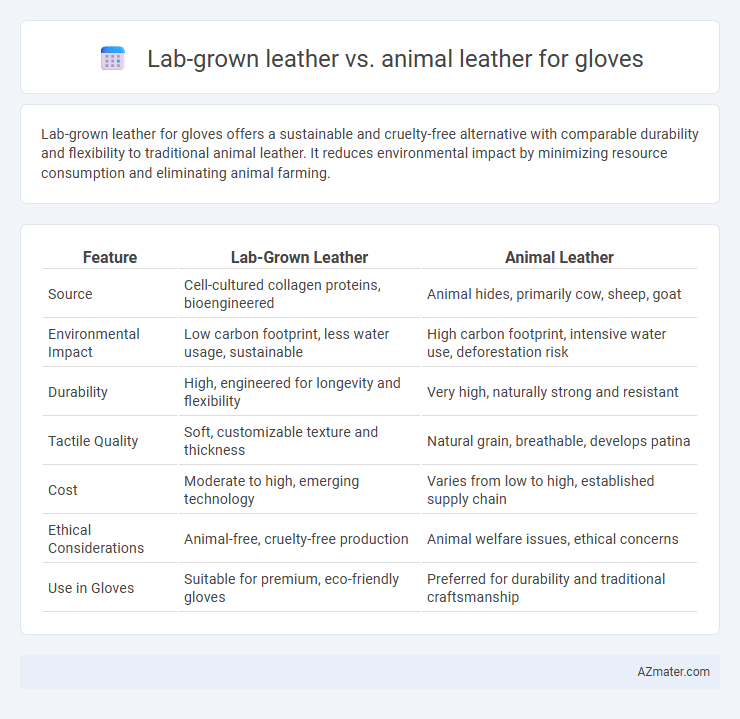Lab-grown leather for gloves offers a sustainable and cruelty-free alternative with comparable durability and flexibility to traditional animal leather. It reduces environmental impact by minimizing resource consumption and eliminating animal farming.
Table of Comparison
| Feature | Lab-Grown Leather | Animal Leather |
|---|---|---|
| Source | Cell-cultured collagen proteins, bioengineered | Animal hides, primarily cow, sheep, goat |
| Environmental Impact | Low carbon footprint, less water usage, sustainable | High carbon footprint, intensive water use, deforestation risk |
| Durability | High, engineered for longevity and flexibility | Very high, naturally strong and resistant |
| Tactile Quality | Soft, customizable texture and thickness | Natural grain, breathable, develops patina |
| Cost | Moderate to high, emerging technology | Varies from low to high, established supply chain |
| Ethical Considerations | Animal-free, cruelty-free production | Animal welfare issues, ethical concerns |
| Use in Gloves | Suitable for premium, eco-friendly gloves | Preferred for durability and traditional craftsmanship |
Introduction to Glove Materials
Lab-grown leather, created through biofabrication processes using collagen from animal cells, offers a sustainable alternative to traditional animal leather in glove manufacturing. Unlike conventional animal leather, which derives from tanned hides of cows or other animals, lab-grown leather significantly reduces environmental impact by minimizing water usage, greenhouse gas emissions, and land exploitation. This innovative material maintains the durability, flexibility, and tactile qualities essential for gloves while addressing ethical concerns associated with animal leather production.
What is Lab-Grown Leather?
Lab-grown leather is an innovative material created by cultivating collagen fibers from animal cells in a controlled environment, resulting in a sustainable alternative to traditional animal leather. This biofabricated leather offers comparable durability, flexibility, and texture, making it suitable for high-quality glove production without the environmental impact of livestock farming. The process reduces greenhouse gas emissions, water usage, and land requirements typically associated with animal leather manufacturing.
Overview of Traditional Animal Leather
Traditional animal leather for gloves is derived from the hides of cattle, goats, and sheep, known for its durability, natural breathability, and ability to conform to the hand over time. This leather undergoes tanning processes using chromium or vegetable-based agents to enhance its strength and resistance to wear, making it a preferred choice for premium gloves in industries like fashion, sports, and work safety. Despite its high performance and luxurious feel, traditional animal leather raises concerns regarding environmental impact, including deforestation, water consumption, and the release of toxic chemicals during tanning.
Durability: Lab-Grown vs Animal Leather Gloves
Lab-grown leather gloves exhibit comparable durability to traditional animal leather, resisting wear and tear while maintaining flexibility over extended use. Animal leather gloves often develop a natural patina, which can enhance durability but may require regular maintenance to prevent cracking. Advances in lab-grown leather technology have improved tensile strength and abrasion resistance, making them a promising sustainable alternative without sacrificing glove longevity.
Comfort and Wearability
Lab-grown leather offers superior breathability and consistent texture, enhancing comfort and reducing hand fatigue during extended glove use. Animal leather, while durable and naturally flexible, may require conditioning to maintain softness and can develop stiffness over time, affecting wearability. Innovations in lab-grown leather ensure moisture-wicking and hypoallergenic properties that cater to sensitive skin, making it an optimal choice for high-performance gloves.
Environmental Impact Comparison
Lab-grown leather for gloves significantly reduces environmental impact by minimizing water consumption and greenhouse gas emissions compared to traditional animal leather production. Animal leather relies on livestock farming, which contributes to deforestation, methane emissions, and extensive land use, whereas lab-grown alternatives use cultured cells, requiring fewer natural resources. This shift toward biotechnological leather production supports sustainable manufacturing processes and lowers the carbon footprint associated with glove materials.
Cost Analysis: Lab-Grown vs Animal Leather
Lab-grown leather offers a cost advantage over traditional animal leather due to lower raw material and processing expenses, with prices projected to decrease further as production scales. Animal leather entails higher costs linked to livestock maintenance, tanning, and environmental compliance, driving overall glove production expenses upward. In glove manufacturing, lab-grown leather promises consistent pricing and reduced labor inputs, presenting a cost-effective and sustainable alternative to animal leather.
Aesthetic and Customization Options
Lab-grown leather for gloves offers superior aesthetic versatility with consistent texture and color, allowing for precise design customization unmatched by animal leather. It enables a wide range of finishes, patterns, and color variations tailored to individual preferences, enhancing personalization possibilities. Animal leather, while rich in natural grain and patina, presents limitations in uniformity and color customization, making lab-grown alternatives more attractive for bespoke glove designs.
Ethical Considerations for Glove Production
Lab-grown leather for gloves presents significant ethical advantages by eliminating the need for animal slaughter and reducing animal cruelty associated with traditional leather production. This sustainable alternative supports animal welfare while offering comparable durability and tactile qualities essential for high-performance gloves. Ethical concerns surrounding resource use and environmental impact are also minimized, making lab-grown leather a responsible choice for conscientious glove manufacturers.
Future Trends in Glove Leather Materials
Lab-grown leather for gloves is gaining traction due to its sustainability and reduced environmental impact compared to traditional animal leather, aligning with increasing consumer demand for eco-friendly products. Advances in biotechnology and material science are enhancing the durability and texture of lab-grown leather, making it competitively resilient for high-performance glove applications. Future trends indicate a shift towards hybrid materials combining lab-grown and bio-based components to optimize comfort, flexibility, and ethical production standards in the glove leather market.

Infographic: Lab-grown leather vs Animal leather for Glove
 azmater.com
azmater.com